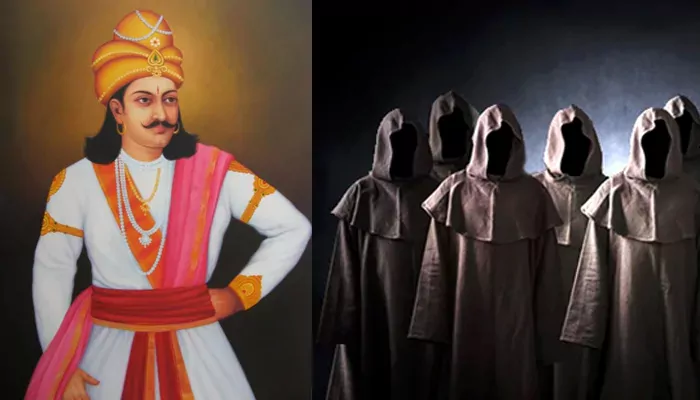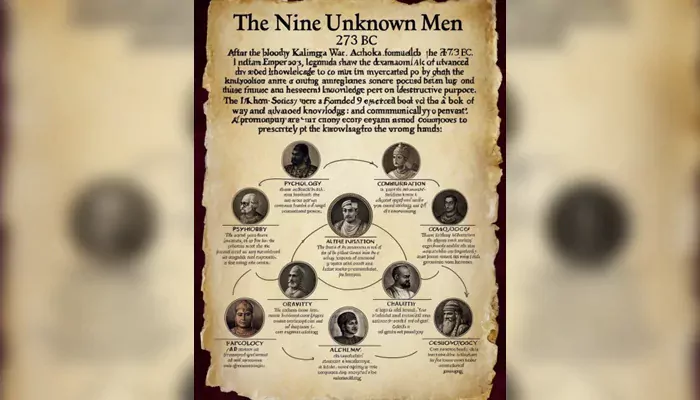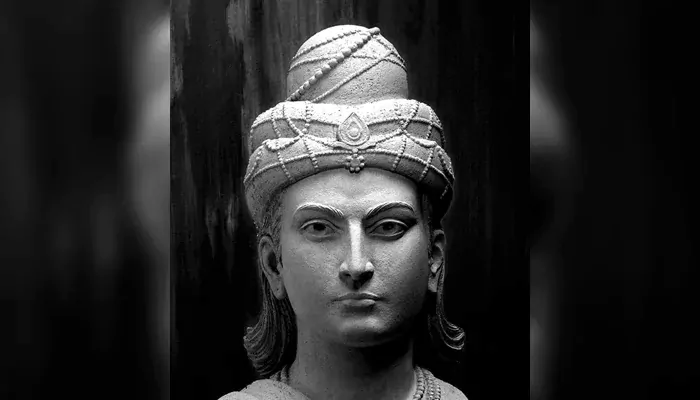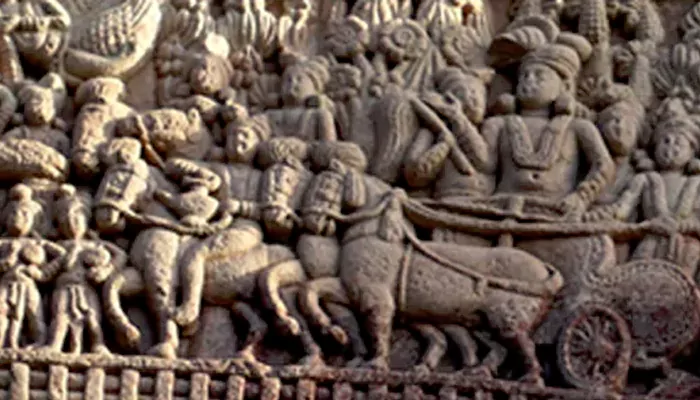
It’s one of India’s most fascinating legends. But behind the mystery, is there a grain of truth?
Emperor Ashoka's story, the fierce warrior who turned into a peace-loving ruler after the bloody Kalinga war, has always stood out in our history books. But beyond the familiar tale of remorse and dharma, there’s a lesser-known chapter that sounds straight out of a thriller. It’s said that Ashoka, disturbed by the destructive potential of certain knowledge, formed a secret society of nine brilliant men. Their mission was to guard dangerous wisdom ranging from time travel to microbiology and keep it hidden from the world. Over the centuries, the legend of these Nine Unknown Men has sparked everything from conspiracy theories to sci-fi plots. However, was this secret brotherhood ever real? Or is it just an ancient myth that’s grown wilder with time?
In this article, we dig deep into the origins of this mysterious tale, exploring where it came from, what researchers say, and whether there’s any truth behind the secrecy.
According to the legend, Ashoka created a covert council of nine intellectuals after the devastating Kalinga War. Their supposed aim was to contain knowledge deemed too powerful or dangerous for the general populace. Each member was responsible for guarding a book dedicated to a different branch of potent knowledge, especially in fields like alchemy, propaganda, physics, and even communication with extraterrestrial life.
As the tale goes, the society maintained its secrecy for a long time. Each time a member died, their post was filled by another expert, handpicked to continue the mission. The idea of such an unbroken chain is, of course, grandly cinematic... but is it historically credible?
Most of what we “know” about the Nine Unknown Men doesn’t stem from ancient Indian sources at all. The first public appearance of the idea came in the 1923 novel 'The Nine Unknown' by Talbot Mundy, serialized in Adventure magazine. Mundy was a British-American writer whose fictional tale depicted the Nine as guardians of hidden truths, pursued by sinister forces seeking their secrets.
🕰️ The Nine Unknown Men: Guardians of Ancient Secrets
— Paranormal Tours (@ParanormalTours) July 7, 2025
🇮🇳 The legend of the Nine Unknown Men is one of India’s most enduring and enigmatic tales, shrouded in mystery, wisdom, and whispers of the paranormal. Said to have been founded by Emperor Ashoka in 273 BCE after the bloody… pic.twitter.com/IxxaZLCRtf
(Credit: Paranormal Tours)
In 1960, French authors Louis Pauwels and Jacques Bergier breathed new life into the idea with their book 'The Morning of the Magicians', a key text in the rise of 20th-century occultism and pseudo-history. They claimed, without evidence, that the Nine Unknown were real and that Ashoka had indeed formed the group around 270 BCE.
Let’s step back from fiction for a moment and look at what we actually know.
Ashoka’s life and rule are among the most well-documented of India’s ancient kings. His inscriptions, known as the Ashokan edicts, are some of the earliest written records from the Indian subcontinent. They reveal a ruler deeply committed to ethical governance, religious tolerance, and public welfare. They do not, however, mention any secret societies or anything resembling a brotherhood of intellectuals guarding forbidden science. Even classical Buddhist chronicles like the Ashokavadana or the Mahavamsa, which detail Ashoka’s religious pursuits and administrative reforms, are silent on any clandestine council. Some historians point to the Arthashastra, the famed ancient Indian treatise on statecraft attributed to Chanakya, as evidence that the Mauryan empire employed spies and secret networks. But espionage is not the same as a secret society preserving advanced scientific knowledge across millennia.

So where, then, did the idea come from? Well, some trace the roots of the legend to 19th-century French author Louis Jacolliot, who wrote extensively (and speculatively) about India. His writings spoke of ancient Indian technological marvels, including supposed radiation purification in the Ganges. But Jacolliot’s claims were laced with the Orientalist romanticism of the colonial era and lacked credible sourcing.
To truly assess whether Ashoka might have created something like the Nine Unknown Men, we must ask: was secrecy consistent with his character and vision? The answer, based on all surviving evidence, is no.
After converting to Buddhism, Ashoka became an active promoter of knowledge and not its suppressor. He built universities, hospitals, and rest houses. He funded missions to spread Buddhist teachings as far as Sri Lanka, Egypt, and the Hellenistic world. And his edicts were made public. So, if a secret society preserving perilous wisdom had existed during his reign, it would likely have left at least a shadow in the literary or archaeological record. But no such trace has been found.

However, Mauryan rulers did use intelligence networks for statecraft, and it’s possible that confidential councils existed. But guarding books on topics like gravity, microbiology, or interstellar communication in 260 BCE stretches historical plausibility to its limit.
Historians are nearly unanimous in their assessment: the Nine Unknown Men is a compelling modern legend but not a historical reality. Romila Thapar, one of India’s most respected ancient historians, has pointed out that Ashoka’s reign is among the best-documented in Indian antiquity. If a secret society of such magnitude had existed, it’s improbable that no contemporary record would mention it. What is well-documented, however, is the extent of open knowledge during Ashoka’s time. Texts like the Charaka Samhita and Sushruta Samhita (treatises on medicine and surgery) were not hidden, but studied and taught widely. The ancient Indian tradition, as per surviving records, leaned towards the dissemination of knowledge, not its restriction.

As for the claims that the Nine influenced Western scientific revolutions or secretly guided the development of technologies like antibiotics or nuclear energy, there’s no credible evidence linking such advances to anything outside of their own historical contexts.
Despite its lack of historical footing, the legend of the Nine Unknown Men has proven remarkably adaptable. Over the decades, it has surfaced repeatedly in novels, documentaries, and even web forums. Writers like Christopher C. Doyle and Shobha Nihalani have drawn inspiration from the tale in their thrillers. The number nine itself (already significant in Hindu cosmology and numerology) has helped the legend nestle into the symbolic world of storytelling. It has also drawn comparisons to other secretive groups like the Illuminati or the Freemasons, and has become a favorite subject in the world of conspiracy lore. From fringe documentaries to internet subreddits, the Nine Unknown Men live on in the modern imagination.
Strip away the wild claims, and what’s left of the Nine Unknown Men is a 20th-century myth built atop a historical emperor’s name, layered with colonial romanticism, and wrapped in the allure of hidden truth. There’s no evidence that Ashoka founded such a group. There are no edicts, and no references in early Buddhist literature. And yet, the story continues to fascinate us. Perhaps that’s because it touches on the human fascination with knowledge and the fear of its misuse. Whether it’s nuclear weapons, genetic engineering, or artificial intelligence, we remain concerned about where unchecked discovery could lead us. The idea that there might be guardians watching over such knowledge is comforting, even if purely imaginary.
The Nine Unknown Men likely never existed. But the world in which they could exist (of ancient wisdom and hidden truths) continues to grip our collective imagination. And that says something important about us. We crave stories that straddle the line between fact and mystery. The legend endures not because it has historic evidence but because it feels timeless.